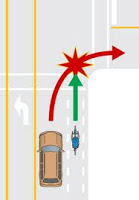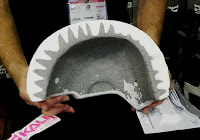
 “Theirs” ………………………….. “Ours”
“Theirs” ………………………….. “Ours”
“Do not make a sudden right turn after passing a bicyclist on your right. Instead, slow down and merge behind the bicyclist before turning.” -New Mexico Driver Manual, pg. 26.
Almost took one on the chin yesterday morning, of the “ours” variety. While riding into the Conoco Hill intersection headed townbound, a lady in a small car quickly overtook me and made a sharp right onto Arkansas/38th and pulled into the Shell station. I did an instant turn inside her and followed her into the gas station.
The lady was apparently of the belief that bike lanes are equivalent to sidewalks, and that I had failed to wait for the WALK light. I explained how the law applies to bike lanes, which are travel lanes for the exclusive use of bicyclists, and that she in fact cut across my lane while I was in it. I admitted that the basic design is a confusing mess, i.e., a motorist is making a right turn from a center lane, and that we both needed to understand the layout and its limitations and avoid its pitfalls. I think she ended up believing that I was telling her good information.
 Need more of these
Need more of these
Until we re-engineer bike lanes at intersections to ameliorate the hooking/crossing conflicts, possibly with protected intersection light cycles or signage such as the one I show here (not sure it is MUTCD compliant), they will be flawed designs, as they force a crisscross maneuver with a cyclist in a motorist’s blind spot and frankly, the law is tough to sort out since a motorist making a turn from as close to the right hand edge as practicable (66-7-322) will be in the bike lane, which is a lane for the exclusive use of bicyclists.
The clearest guidance is the basic idea (66-7-317) that you can’t leave a lane until it is safe to do so. Indeed clear guidance is provided by the New Mexico Driver Manual, pg. 26: “Do not make a sudden right turn after passing a bicyclist on your right. Instead, slow down and merge behind the bicyclist before turning.” But given the usual motorist (and occasional police) confusion about the law, lack of training, and pure cluelessness, I conclude that you had better be on your situational awareness toes and up to date on your bike handling practice sessions. Don’t put your safety in anyone else’s hands.
Often, I leave the bike lane and occupy the appropriate travel lane as I approach an intersection in order to avoid this scenerio–its not “practicable” to put one’s self in a dangerous situation. Riding slowly uphill on Diamond at Conoco Hill (is it now “Shell Hill”?) isn’t one of those times, but it does leave me a little vulnerable to other people’s mistakes. My typical low speed on cresting Conoco Hill works in my favor as far as safety. I look at it as good bike handling/situational awareness practice, and the occasional “teaching moment.” But in general, one has to consider that being in a bike lane on a street with a lot of turning and crossing traffic, such as on Diamond south of Orange/Sandia, can be hazardous to one’s health.
On another topic of occasional interest there is an excellent helmet article in the June hardcopy issue of Bicycling Magazine. Title is “Senseless” and it is a very well researched discussion on helmet design, testing standards, and current research into helmet design improvements and what is holding them back (fossilized standards, for the most part). If you want to learn something at the layperson’s level about current helmet research, go buy a copy. Its really worth the price of the magazine. New designs in progressive foam compression and rotational acceleration management promise to make significant improvements in the old brain bucket, if these go into full production. Right now, Scott and Cannondale offer models with the “conehead” foam design, which is supposed to provide better management of deceleration by providing two interacting foams, one that compresses readily and one that is stiffer (see picture below). Go read the article and click over to the foam discussion on Randy Swart’s helmets.com for more authoritative information than I will put here in the interests of not violating copyrights or exceeding my limited expertise on the topic.
 A “conehead”multifoam design photo and discussion at helmets.com
A “conehead”multifoam design photo and discussion at helmets.com
I won’t get into all the political, ethical, and sometimes downright silly arguments pro or con helmets here. Decide for yourself. But one thing that seems to make sense from the Bicycling article is that the lack of correlation between decreased numbers of all brain injuries and increased helmet wearing can be explained by the decades-old helmet design, which is built to prevent one model injury, a very serious linear (ie., not shear rotation) impact mitigated by a very stiff foam. Lesser injuries, including concussion and shear damage, are still possible.
Seems like a sort of crappy post for National Bike Month on this site, but I’d rather you be safe than complacent. Keep the rubber side down and slip those punches!

